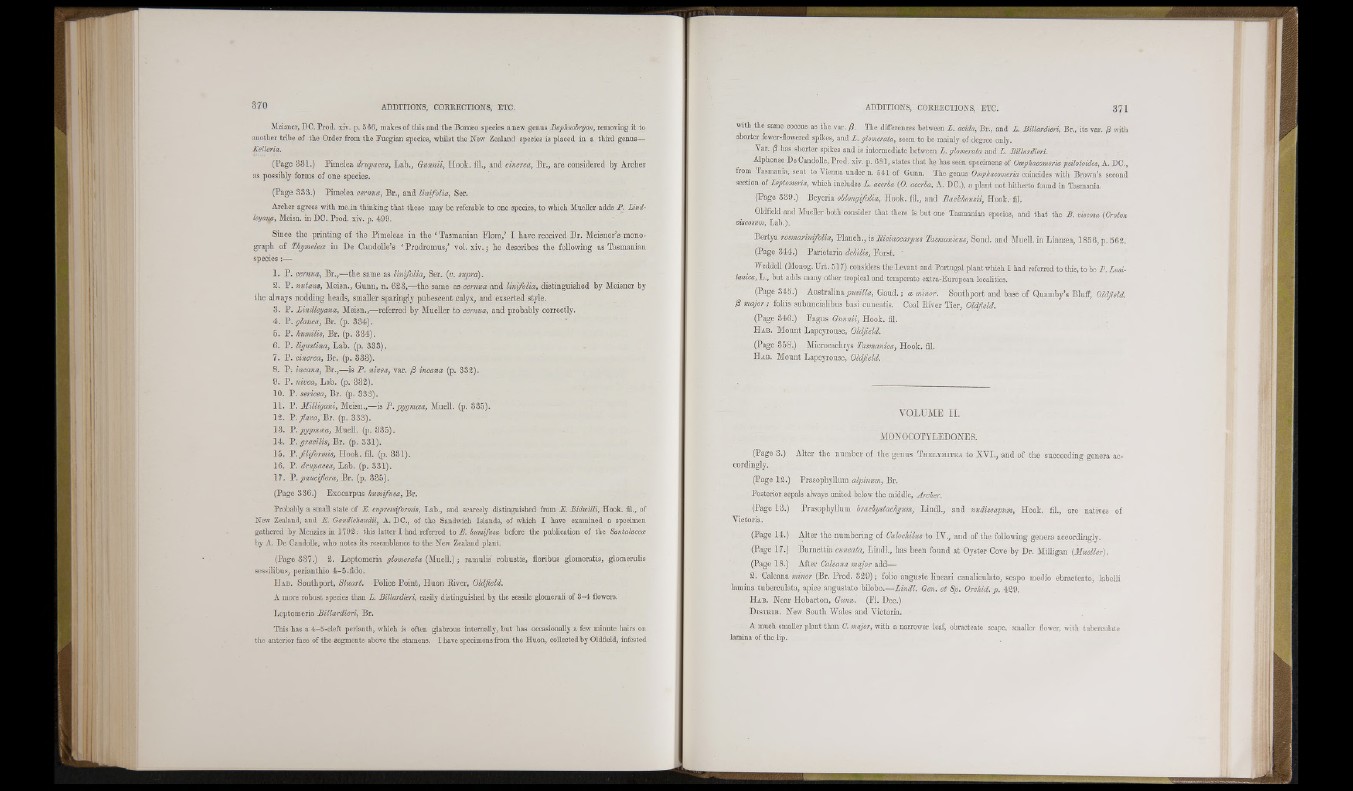
li
Jleisnev, DC. Prod. xiv. p. 566, makes of this and the Borneo species anew genus Baphiobryon.vcmovi'ag it to
another tribe of the Order from the Euegian species, whilst the New Zealand species is placed iu a third genus—
Kelleria.
T N I
(Page 331.) Pimelea drupácea, Lab., Gunnii, Hook, fil., and cinerea, Br., are considered by Archer
as possibly forms of one species.
(Page 333.) Pimelea cernua, Br., and linifolia, Ser.
Archer agrees with me.in thinking that these may be referable to one species, to which Mueller adds P. Lind-
leyana, Meisn. in DC. Prod. xiv. p. 499.
Since the printing of the Pimeleas iu the ‘ Tasmanian Plora,’ I have received Dr. Meisner’s monograph
of Thjmelea iu De Candolle’s ‘ Prodromus,’ vol. xiv. ; he describes the following as Tasmanian
species :—
1. P. cernua, Br.,—the same as linifolia, Ser. [v. supra).
2. P . nutans, "Meisn., Gunn, n. 623,—the same as cernua and linifolia, distiuguished by Meisner by
the always nodding heads, smaller sparingly pubescent calyx, and exserted style.
3. P. Lindleyana, Meisn.,—referred by Mueller to cernua, and probably correctly.
4. P. glauca, Br. (p. 334).
5. P. humilis, Br. (p. 334).
6 . P. ligustina, Lab. (p. 333).
7. P. cinerea, Br. (p. 333).
8. P . incana, Br.,—^is P . nivea, var. /S incana (p. 332).
9. P. nivea, Lab. (p. 332).
10. P. sericea, Br. (p. 333).
11. P . Milligani, Meisn.,—is P. pygmæa, Muell. (p. 335).
12. P . / a r « , Br. (p. 333).
13. V .pygmæa, Muell. (p. 335).
14. Y . gracilis, Br. (p. 331).
15. Y . fiUformis, Hook. fil. (p. 331).
16. P. drupácea, Lab. (p. 331).
17. Y.paucifora, Br. (p. 335).
(Page 336.) Exocarpus humifusa, Br.
Probably a small state of E. cupressiformis, Lab., and scarcely distinguished from E. Bidwilli, Hook, fil., of
New Zealand, and E. Gaudichaudii, A. DC., of the Sandwich Islands, of which I have examined a specimen
gathered by Menzies iu 1793 : this latter I had referred to E. humifusa before the publication of the Santalaceæ
by A. De Candolle, who notes its resemblance to the New Zealand plant.
(Page 337.) 2. Leptomeria glomerata {fixitW.) ; ramulis robustis, fioribus glomeratis, glomerulis
sessilibu.-?, perianthio 4-5-fido.
H a b . Southport, Stuart. Police Point, Huon River, Oldfield.
A more robust species than L. Billardieri, easily distinguished by the sessUe glomeruli of 3-4 flowers.
Leptomeria Billardieri, Br.
This has a 4-5-cleft perianth, whieh is often glabrous internally, but has occasionally a few minute hairs on
the anterior face of the segments above the stamens. I have specimens from the Huon. collected by Oldfield, infested
with tlie same coccus as the var. 0. The diflercnces between L. acida, Br,, and L. Billardieri, Br., its var. 0 with
sliorter fewer-flowered spikes, and L. glomerata, seem to be mainly of degree only.
"Var. 0 lias shorter spikes and is intermediate between L. glomerata and L. Billardieri.
Alphonse De CandoUe, Prod. xiv. p . 681, states that he has seen specimens of Omphacomeria psilotoides, A. DC.,
from Tasmania, sent to Vienna under n. 541 of Gunn. The genus Omphacomeria coincides with Brown’s second
section of Leptomeria, which includes L. acerba (0. acerba, A. DC.), a plant not hitherto found in Tasmania.
(Page 339.) Beyeria ollongifolia, Hook, fil., and Backhousii, Hook. fil.
Oldfield and MueUer both consider that there is but oue Tasmanian species, and that the B. viscosa (Croton
viscosum, Lab.).
Bertya rosmarinifolia, Piauch., is Ricinocarpus Tasmanicus, Sond. and Muell, in Linnæa, 1856, p. 562.
(Page 344.) Parietaria dehilis, Porst. '
"VVeddell (Monog. Urt. 517) considers tlie Levant and Portugal plant wliich I had referred to this, to be P. Lusi-
tanica, L., but adds mauy other tropical and temperate extra-European localities.
(Page 345.) KxLsitdlmapusilla. Gaud. ; a minor. Southport and base of Quamby’s Bluff, Oldfeld.
E major ; foliis subuncialibus basi cuueatis. Coal River Her, Oldfield.
(Page 346.) Fagus Gunnii, Hook. fil.
H a b . Mount Lapeyrouse, Oldfeld.
(Page 358.) Microcachrys Tasmanica, Hook. fil.
H a b . Mount Lapeyrouse, Oldfield.
VOLUME II.
MONOCOTYLEDONES.
(Page 3.) Alter the number of the genus THELTiiiTR.i to XVI., and of the succeeding genera accordingly.
of
(Page 12.) Prasophyllum alpinum, Br.
Posterior sepals always imited below the middle. Archer.
(Page 13.) Prasophyllum brachystachyum, Liudl,, and nudiscapum. Hook, fil., are natives
Victoria.
(Page 14.) Alter the iiuraberiug of Calochilus to IV., and of the following genera accordingly.
(Page 17.) Burnettia cuneata, Lindi., has been found at Oyster Cove by Dr. Milligan (Mueller).
(Page 18.) After Caleana major add—
2. Caleana minor (Br. Prod. 329) ; folio anguste lineari canaliculate, scapo medio ebracteate, labelli
lamiua tuberculata, apice angustato bilobo.— Lindl. Gen. et Sp. Orchid, p . 429.
I I a b . Near Hobarton, Gunn. (Fl. Dec.)
D istrib. New South "Wales and Victoria.
A mucli smaller plaut than C. major, with a narrower leaf, ebracteate scape, smaller flower, with tuberculate
lamina of the lip.